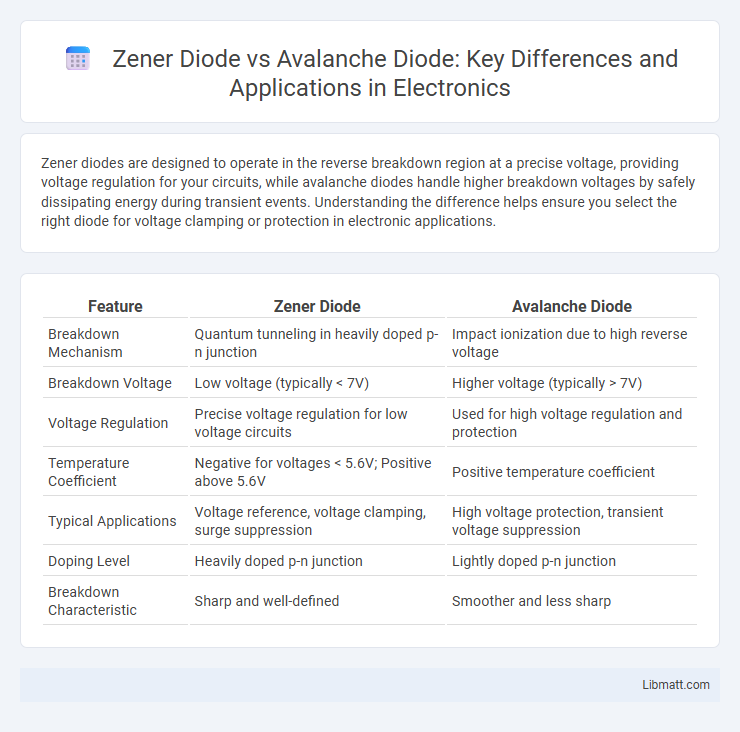Zener diodes are designed to operate in the reverse breakdown region at a precise voltage, providing voltage regulation for your circuits, while avalanche diodes handle higher breakdown voltages by safely dissipating energy during transient events. Understanding the difference helps ensure you select the right diode for voltage clamping or protection in electronic applications.
Table of Comparison
| Feature | Zener Diode | Avalanche Diode |
|---|---|---|
| Breakdown Mechanism | Quantum tunneling in heavily doped p-n junction | Impact ionization due to high reverse voltage |
| Breakdown Voltage | Low voltage (typically < 7V) | Higher voltage (typically > 7V) |
| Voltage Regulation | Precise voltage regulation for low voltage circuits | Used for high voltage regulation and protection |
| Temperature Coefficient | Negative for voltages < 5.6V; Positive above 5.6V | Positive temperature coefficient |
| Typical Applications | Voltage reference, voltage clamping, surge suppression | High voltage protection, transient voltage suppression |
| Doping Level | Heavily doped p-n junction | Lightly doped p-n junction |
| Breakdown Characteristic | Sharp and well-defined | Smoother and less sharp |
Introduction to Zener and Avalanche Diodes
Zener diodes operate based on the Zener breakdown phenomenon, allowing them to maintain a stable voltage across them when reverse-biased, making them ideal for voltage regulation applications. Avalanche diodes utilize the avalanche breakdown mechanism, where carriers collide and generate additional carriers, enabling high-current and high-voltage tolerance in protective devices. Both diodes exhibit controlled breakdown behavior but differ in breakdown voltage ranges and applications due to their distinct physical mechanisms.
Construction and Working Principle
Zener diodes are designed with a heavily doped p-n junction, enabling controlled breakdown at a precise reverse voltage called the Zener voltage, where they conduct current to regulate voltage without damage. Avalanche diodes have a lightly doped junction and rely on impact ionization in the avalanche breakdown region, allowing current flow when the reverse voltage exceeds a threshold, protecting circuits from voltage spikes. Both diodes exploit different breakdown mechanisms--Zener breakdown for heavily doped junctions and avalanche breakdown for lightly doped junctions--making their construction critical to their distinct operating principles.
Voltage Breakdown Mechanisms
Zener diodes operate primarily through quantum mechanical tunneling at breakdown voltages typically below 5-6 volts, resulting in a sharp voltage regulation characteristic. Avalanche diodes rely on impact ionization, where carriers gain enough energy to create electron-hole pairs, causing breakdown at higher voltages usually above 6 volts. Both diodes use these distinct voltage breakdown mechanisms for voltage clamping and surge protection in electronic circuits.
Key Electrical Characteristics
Zener diodes operate by breakdown at precise low reverse voltages, typically between 2.4V and 7.5V, allowing voltage regulation with sharp knee voltage and low dynamic resistance. Avalanche diodes function under higher reverse voltages, usually above 6V, with breakdown caused by impact ionization, featuring a more gradual breakdown voltage and higher avalanche energy capacity. Your choice depends on required voltage precision and energy absorption rating for stabilization or protection circuits.
Symbol and Circuit Representation
The Zener diode symbol features a standard diode shape with bent edges on the cathode line, indicating its voltage regulation capability, while the avalanche diode symbol closely resembles a regular diode but may include additional markings denoting its avalanche breakdown functionality. In circuit representation, the Zener diode is commonly depicted with the cathode connected to the reference voltage, emphasizing its operation in the reverse breakdown region for voltage stabilization. The avalanche diode is shown in circuits often as a protective device to prevent voltage spikes, connected in reverse bias to shunt transient voltages safely without damage.
Applications in Electronic Circuits
Zener diodes are primarily used for voltage regulation and reference in electronic circuits, providing stable voltage levels in power supplies and protecting circuits from voltage spikes. Avalanche diodes serve as protectors against high-voltage transients, commonly used in surge protection devices to safely dissipate excess energy. You can choose Zener diodes for precise voltage clamping, while avalanche diodes excel in safeguarding sensitive components from sudden voltage surges.
Performance Under Reverse Bias
Zener diodes maintain a stable and precise voltage under reverse bias by operating within the Zener breakdown region, which occurs at low reverse voltages typically below 5V. Avalanche diodes function under higher reverse voltages, safely handling higher energy surges by entering avalanche breakdown with less precision but greater robustness. The Zener diode offers sharper voltage regulation ideal for low voltage applications, while avalanche diodes excel in protecting circuits against high-voltage transients.
Differences in Temperature Coefficient
Zener diodes exhibit a negative temperature coefficient below 5.6V, meaning their breakdown voltage decreases as temperature rises, while above 5.6V, they show a positive temperature coefficient due to avalanche breakdown. Avalanche diodes consistently possess a positive temperature coefficient, with their breakdown voltage increasing at higher temperatures, enhancing stability in power regulation applications. These contrasting temperature behaviors influence the selection of diodes in voltage reference circuits and overvoltage protection designs.
Choosing the Right Diode for Your Application
When selecting between a Zener diode and an avalanche diode, consider the voltage regulation and breakdown characteristics specific to your application. Zener diodes provide precise voltage regulation at lower breakdown voltages, making them ideal for voltage reference and clamping in circuits operating typically below 7V to 200V. Avalanche diodes handle higher voltage spikes and protect sensitive components from transient surges by breaking down safely without damage, suitable for applications requiring robust surge protection.
Summary: Zener vs Avalanche Diode
Zener diodes are designed to operate in the breakdown region with a precisely controlled voltage, commonly used for voltage regulation and reference applications. Avalanche diodes rely on avalanche breakdown occurring at higher voltages, making them suitable for protecting circuits against transient voltage spikes. Your choice between Zener and avalanche diodes depends on the specific voltage and current characteristics required for stable operation or surge protection.
Zener vs Avalanche diode Infographic

 libmatt.com
libmatt.com